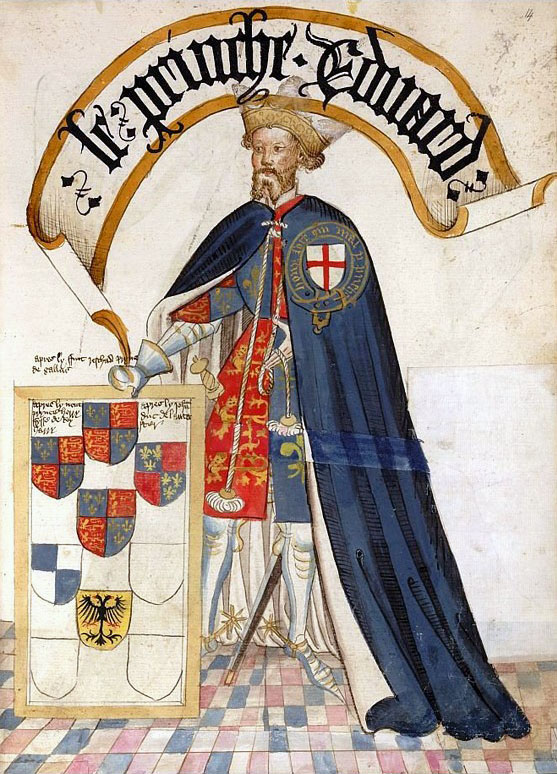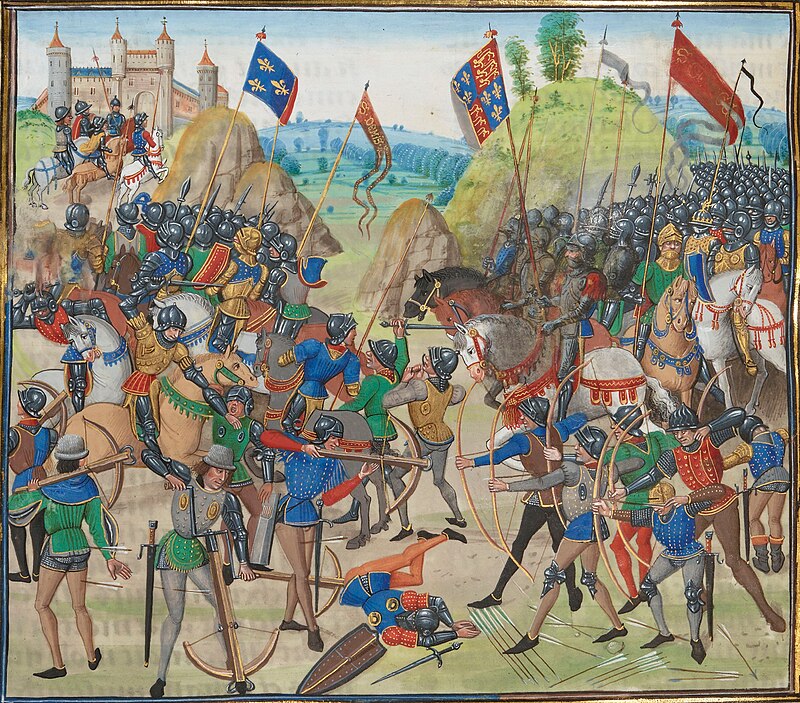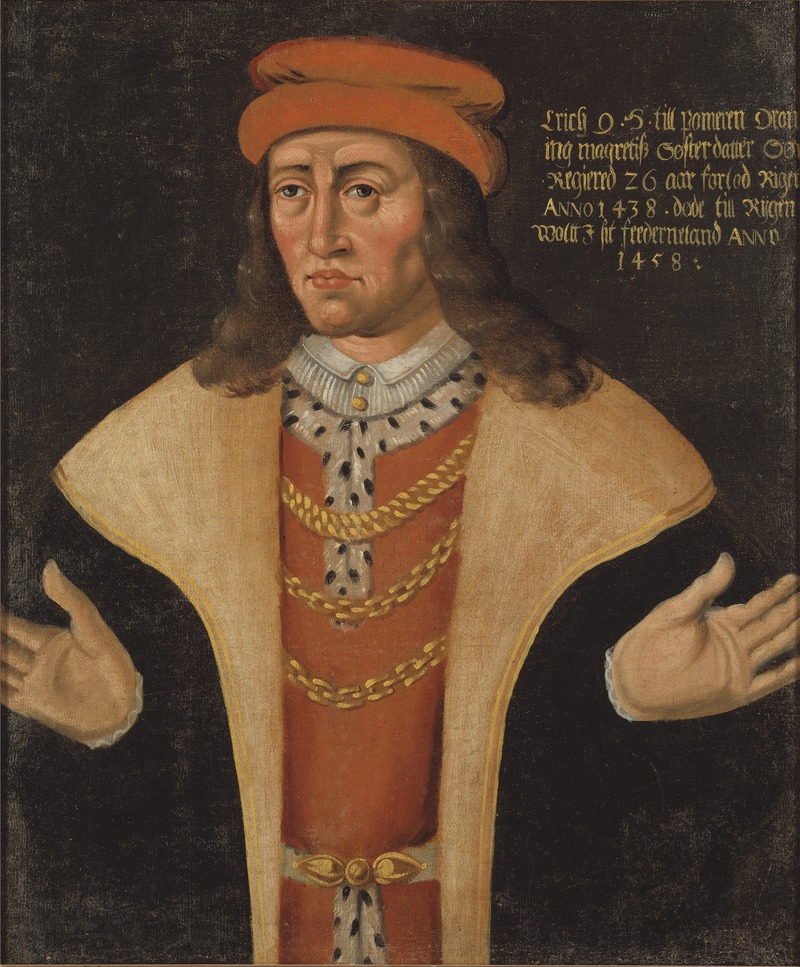by Susan Flantzer © Unofficial Royalty 2017
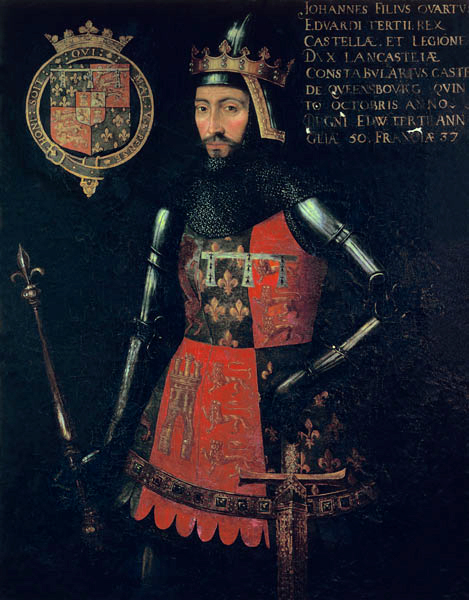
John of Gaunt, 1st Duke of Lancaster, circa 1593, probably modeled after his tomb effigy; Credit – Wikipedia
John of Gaunt was the fourth son but the third surviving son of King Edward III of England and Philippa of Hainault. It was through John’s first marriage that the Duchy of Lancaster eventually became a possession of the British Crown. John is also quite important in royal genealogy. His daughter Catherine of Lancaster married King Enrique III of Castile and León, which made John the grandfather of King Juan II of Castile and the ancestor of all subsequent monarchs of Castile and a united Spain. His daughter Philippa of Lancaster married King João I of Portugal making all future Portuguese monarchs descendants of John. All monarchs of England, Great Britain, and the United Kingdom since King Henry IV are descended from John of Gaunt, and most European monarchies are also descended from John. The Houses of Lancaster, York, and Tudor were all descended from John of Gaunt’s children:
- King Henry IV (Lancaster: father of King Henry V, grandfather of King Henry VI)
- Joan Beaufort (York: grandmother of King Edward IV and King Richard III)
- John Beaufort (Tudor: great-grandfather of King Henry VII)
John of Gaunt was born on March 6, 1340, at the Abbey of St. Bavon in Ghent, County of Flanders, now in Belgium. At the time of his birth, Ghent was known as Gaunt in English, hence his name, John of Gaunt. King Edward III and his wife were in Flanders to formally receive homage from the Count of Flanders and to have the cities of Ghent, Ypres, and Bruges proclaim Edward III as King of France. From 1337 to 1453, the English and the French fought the Hundred Years’ War for control of the Kingdom of France. It was ultimately an unsuccessful war for the English that involved King Edward III, his sons, and their descendants for a long period.
John had thirteen siblings:
- Edward, Prince of Wales, the Black Prince (1330 – 1376), married Joan, 4th Countess of Kent, had issue (King Richard II of England)
- Isabella of England (1332 – 1379) married Enguerrand VII de Coucy, 1st Earl of Bedford, had issue
- Joan of England (1333/1334/1335 – 1348), died of the plague on the way to marry Pedro of Castile
- William of Hatfield (born and died 1337)
- Lionel of Antwerp, 1st Duke of Clarence (1338 – 1368), married (1) Elizabeth de Burgh, 4th Countess of Ulster, had issue (2) Violante Visconti, no issue
- Edmund of Langley, 1st Duke of York (1341 – 1402), married (1) Infanta Isabella of Castile, had issue (2) Joan Holland, no issue
- Blanche of the Tower (born and died March 1342)
- Mary of Waltham (1344 – 1362), married John V, Duke of Brittany, no issue
- Margaret of Windsor, Countess of Pembroke (1346 – 1361), married John Hastings, 2nd Earl of Pembroke, no issue
- Thomas of Windsor (1347 – 1348), died of the plague
- William of Windsor (born and died 1348), died of the plague
- Thomas of Woodstock, 1st Duke of Gloucester (1355 – 1397), married Eleanor de Bohun, had issue
John grew up in the household of his elder brother Edward, Prince of Wales (the Black Prince) where he received his knightly training. He experienced battle for the first time at the age of ten when he was on board a ship with his brother the Prince of Wales at the naval Battle of Winchelsea. When John was nineteen years old, he commanded, for the first time, his own troops during a grueling winter campaign in Normandy.
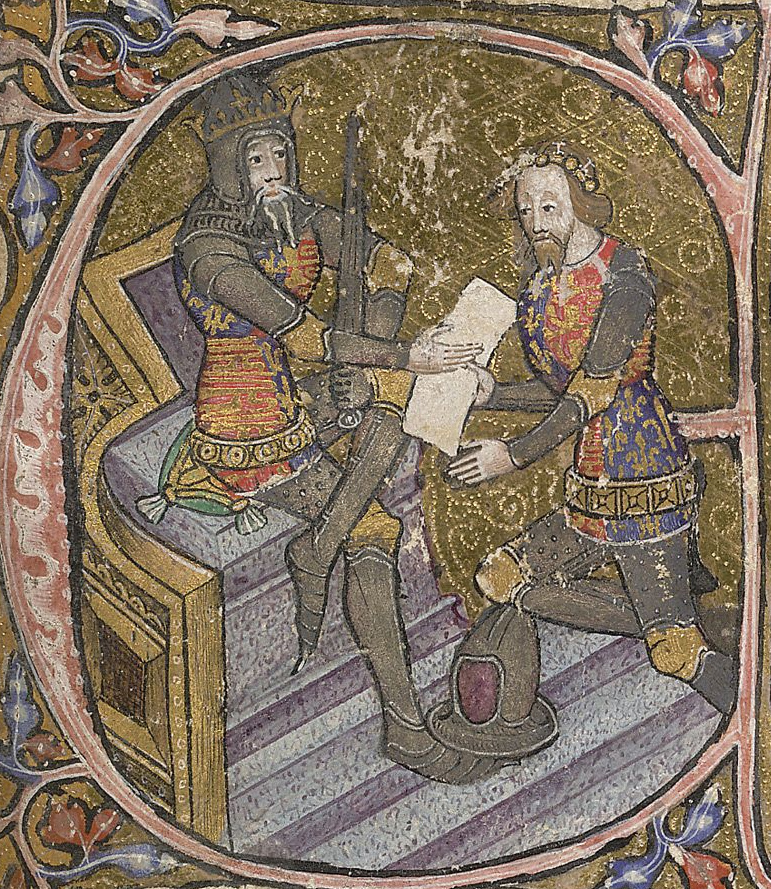
John’s father King Edward III and his eldest brother Edward, Prince of Wales (the Black Prince); Credit – Wikipedia
Following his father’s plan for his sons to marry wealthy heiresses, John married Blanche of Lancaster on May 19, 1359, in the Queen’s Chapel at Reading Abbey in Reading, England. The bride was 14 years old and the groom was 19 years old. Blanche’s father was Henry of Grosmont, 1st Duke of Lancaster, a great-grandson of King Henry III of England. Blanche had only one sibling, an elder sister, Maud. Blanche and John were third cousins, both being great-great-grandchildren of King Henry III. This was an excellent match for both Blanche and John. Blanche was marrying into the royal family and John’s wealth was greatly increased by marrying one of the richest heiresses in England.

Marriage of John of Gaunt and Blanche of Lancaster in Reading Abbey on by Horace Wright (1914)
Description of the above painting from the Reading Museum where the painting is on display: “In this painting, John of Gaunt and his bride walk from beneath a gilded canopy towards the officiating Bishop of Salisbury. Four lords support the wedding canopy. The one nearest to Blanche is her father, Henry, Duke of Lancaster. Close by is the poet Chaucer, clothed in black and bearing a scroll. On the throne is John’s father, King Edward III, beneath a crimson canopy decorated with the lions of England. Beside the King are two of the royal princes, Edward the Black Prince and Prince Lionel.”
Blanche and John had seven children:
- Philippa of Lancaster (1360 – 1415), married King João I of Portugal, had issue
- John (c.1362/1364), died in infancy
- Elizabeth of Lancaster (1364 – 1426), married (1) John Hastings, 3rd Earl of Pembroke (2) John Holland, 1st Duke of Exeter, had issue (3) John Cornwall, 1st Baron Fanhope, had issue
- Edward of Lancaster (born and died 1365)
- John of Lancaster (born and died 1366), died in early infancy
- King Henry IV of England (1367 – 1413), married (1) Mary de Bohun, had issue including King Henry V of England (2) Joanna of Navarre, no issue
- Isabella of Lancaster (born 1368), died young
Blanche’s father died in 1361 and her sister died in 1362, making Blanche the sole heiress. At this time, it was common for extinct titles of heiresses’ fathers to pass to their husbands. John of Gaunt was created Duke of Lancaster on November 13, 1362. By that time, his wealth was immense. He owned thirty castles and estates in England and France. His household was comparable in size and organization to that of a monarch, and his annual income was between £8,000 and £10,000 a year, several million pounds in today’s terms. This was the beginning of today’s Duchy of Lancaster which descended to John of Gaunt’s son King Henry IV and has remained in the British Crown ever since.
The Duchy of Lancaster is one of the two royal duchies in England and is held in trust for the Sovereign to provide income for the use of the British monarch. The other royal duchy is the Duchy of Cornwall which provides a similar purpose for the eldest son of the reigning British monarch. The monarch, regardless of gender, has the style of Duke of Lancaster. The duchy comprises 46,000 acres and includes urban developments, historic buildings, and farmland in many parts of England and Wales, and large holdings in Lancashire. The Sovereign is not entitled to the capital of the Duchy’s portfolio or capital profits. Revenue profits are distributed to the Sovereign and are subject to income tax.
On September 12, 1368, Blanche died at age 23, possibly of the plague or possibly from childbirth complications, while John was away at sea. Most of England’s nobility and clergy attended her funeral at the Old St. Paul’s Cathedral in London, England. John held annual commemorations of Blanche’s death for the rest of his life and built a magnificent double tomb at St. Paul’s Cathedral for Blanche and himself. Although he married two more times, when John died in 1399, he was buried with Blanche.
John married again on September 21, 1371, to Infanta Constance of Castile, the daughter of Pedro I, King of Castile and León. Constance was the elder surviving daughter and co-heiress of her father. Her younger sister Isabella married John’s younger brother Edmund of Langley. In 1369, Pedro the Cruel, King of Castile and León had been killed by his half-brother who then assumed the throne of Castile and León. After his marriage to Constance, John assumed the style of King of Castile and León in the right of his wife. However, he was never able to gain control of the kingdom. In 1388, John renounced any claim in favor of King Enrique III, who later married Catherine of Lancaster, the daughter of John and Constance. Constance died on March 24, 1394, at Leicester Castle in England at the age of 40. She was buried at the Church of the Annunciation of Our Lady of the Newarke in Leicester, England where several other Lancasters were buried.
Constance and John had two children:
- Catherine of Lancaster (1372–1418), married King Enrique III of Castile and León, had issue
- John of Lancaster (1374–1375)

Constance of Castile; Credit – Wikipedia
During the 1370s and the 1380s, John was one of England’s principal military commanders, but he never received the acclaim that his elder brother Edward the Black Prince received. In August 1373, John invaded France and marched unopposed from Calais on the English Channel to Bordeaux in Aquitaine, a distance of 550 miles. He negotiated a truce with France at Bruges, Flanders in 1375. From 1374 until 1377, John was effectively the head of the English government due to the illness of his father and elder brother. On June 8, 1376, at the age of 45, John’s eldest brother and heir to the throne, Edward, Prince of Wales (the Black Prince) died at the age of 45. The heir to the throne became Edward’s only surviving child, nine-year-old Richard. A year later King Edward III died and was succeeded by his ten-year-old grandson King Richard II. At King Richard II’s coronation, John acted as High Steward, carried the Sword of Mercy, and carved at the coronation banquet.
King Richard II’s coronation occurred on July 16, 1377, at Westminster Abbey, just eleven days after his grandfather’s funeral. The quickness with which all this happened was certainly affected by the controversial succession of a child king whose father had not been the king. Some believed that one of King Edward III’s younger sons (there were three still alive: John of Gaunt, Duke of Lancaster; Edmund of Langley, Duke of York; and Thomas of Woodstock, Duke of Gloucester) should be king. Parliament, in a dispute with John of Gaunt at that time, supported Richard’s accession to the throne. John of Gaunt and his two brothers were excluded from councils that ruled during Richard’s minority, but as the king’s uncles, they still held great informal influence over the government.
Since 1337, England had been fighting France in the Hundred Years’ War, and the English had consistently lost territory to the French since 1369. King Richard II wanted to negotiate peace with France, but much of the nobility wanted to continue the war. In 1386, Parliament blamed Richard’s advisers for the military failures and accused them of misusing funds intended for the war. Parliament authorized a commission of nobles known as the Lords Appellant to take over the kingdom’s management and act as Richard’s regents. In 1387, the Lords Appellant launched an armed rebellion against King Richard II and defeated an army loyal to him at the Battle of Radcot Bridge, outside Oxford. They maintained Richard as a figurehead with little real power. Parliament convicted almost all of Richard’s advisers of treason. Most of the advisers were executed and a few were exiled.
Richard’s uncle John of Gaunt left England in 1386 to seek the throne of Castile, claimed by the right of his second wife, Constance of Castile, whom he had married in 1371. Because of the crisis in England, in 1389, John of Gaunt returned from Castile, enabling King Richard II to rebuild his power gradually until 1397, when he reasserted his authority and destroyed the principal three men among the Lords Appellant.
Katherine Swynford, John’s longtime mistress, was his third wife. They married on January 13, 1396, at Lincoln Cathedral in England. Katherine originally was a governess to John’s daughters by his first wife, Philippa and Elizabeth. Sometime after the death of Blanche of Lancaster in 1368 and the birth of John and Katherine’s first child in 1373, John and Katherine began an affair that produced four children. The children were given the surname “Beaufort” after a former French possession of John. After the marriage of John and Katherine, their four children were legitimized by both King Richard II of England and Pope Boniface IX. After John’s eldest son deposed his first cousin, King Richard II, in 1399, the new King Henry IV inserted a phrase excepta regali dignitate (“except royal status”) in the documents which legitimized his Beaufort half-siblings which barred them from the throne.
John and Katherine had three sons and one daughter:
- John Beaufort, 1st Earl of Somerset (1373–1410), married Margaret Holland, had issue, great-great-grandparents of King Henry VII
- Henry, Cardinal Beaufort, Bishop of Winchester (1375–1447), unmarried
- Thomas Beaufort, Duke of Exeter (1377–1426), married Margaret Neville of Horneby, no surviving issue
- Joan Beaufort, Countess of Westmorland (1379–1440), married (1) Robert Ferrers, 5th Baron Boteler of Wem, had issue, ancestors of many notable persons including Queen Elizabeth the Queen Mother; Diana, Princess of Wales; Catherine, Duchess of Cambridge; George Washington, etc. (2) Ralph de Neville, 1st Earl of Westmorland, had 14 children, grandparents of King Edward IV and King Richard III
John of Gaunt died on February 3, 1399, at Leicester Castle in England at the age of 58. His nephew King Richard II had visited John before his death. Although he married two more times, John was buried with his first wife Blanche at Old St. Paul’s Cathedral in London. Unfortunately, the Great Fire of 1666 destroyed Old St. Paul’s Cathedral and the magnificent tomb of Blanche and John. Katherine Swynford, John’s widow, survived him for four years, dying on May 10, 1403. She was buried at Lincoln Cathedral.

The tomb of Blanche of Lancaster and John of Gaunt, destroyed during the Great Fire of London of 1666. Credit: Wikipedia
This article is the intellectual property of Unofficial Royalty and is NOT TO BE COPIED, EDITED, OR POSTED IN ANY FORM ON ANOTHER WEBSITE under any circumstances. It is permissible to use a link that directs to Unofficial Royalty.
Works Cited
Abrufstatistik. “John of Gaunt, 1. Duke of Lancaster.” Wikipedia. N.p.: Wikimedia Foundation, n.d. Web. 5 Dec. 2016.
“John of Gaunt.” Wikipedia. N.p.: Wikimedia Foundation, 16 Nov. 2016. Web. 5 Dec. 2016.
Jones, Dan. The Plantagenets. New York: Viking, 2012. Print.
“Katherine Swynford.” Wikipedia. N.p.: Wikimedia Foundation, 16 Nov. 2016. Web. 5 Dec. 2016.
Williamson, David. Brewer’s British Royalty. London: Cassell, 1996. Print.








